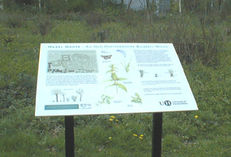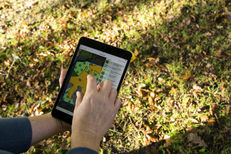The Biodiversity Survey
A biodiversity survey of a campus can be considered to have three elements.
- Habitats and campus features.
- Species surveys.
- Monitoring and repeat surveys.
Before you begin make sure that you:
- Undertake a risk assessment;
- Check for existing survey information held by staff, students, biological records centres, local authorities or local wildlife groups;
- Get expert advice and help from people with experience of ecology;
- Choose the best time of year – for most species this will be spring and summer;
- Get somebody to help you. It is usually easier to survey with two people; and
- That you have all the necessary equipment.
Habitats and campus features
Your first survey will usually be to identify habitats that are important or potentially important for biodiversity and/or recreation. You can also identify areas that may be suitable for habitat creation projects and make notes on management changes that may be necessary.
You may want to consult the JNCC ‘Handbook for Phase 1 Habitat Surveys’. This contains detailed guidance on the national system for mapping habitats according to habitat descriptions. You can adapt this approach according to your needs. For example, creating additional sub-categories of habitats. You can also use the Phase One App which has been developed at Oxford Brookes University.
You should aim to indicate and describe habitats that are present on a large scale map. You can do this in simple terms such as ancient woodland, newly planted woodland, scattered trees, species rich grassland, unmanaged/managed grass, ponds, hedges, bird boxes, bat boxes. Once you have broad habitats and species described, you can add more detail e.g. sub-divide a wood according to management practices.
Species Surveys
Once you have identified species that are important in your local area you can undertake targeted surveys to see if they may be present on site. Alongside these, general surveys will allow you to start to build a picture of how ‘species-rich’ your campus is.
There are a range of national surveys organised by conservation groups who provide guidance and resources to help you undertake simple species surveys. The results of these surveys also help species conservation on a national level. Examples include BioBlitz, the RSPB Big Garden Birdwatch and BeeWatch. A detailed list of surveys that you could get involved with is provided in ‘Further Information’.
Detailed species surveys are likely to require the help of in-house or local experts. Find the experts in your institution and make contact with local groups who will often help with surveys of species such as birds, bats, moths and plants.
Monitoring and repeat surveys
Monitoring is needed to examine progress, report on the results of your management and for you to see what changes are happening to biodiversity on your campus. You need to:
- Make accurate initial observations;
- Compile careful records; and
- Make follow-up observations using the same methods.
Record Keeping
The records you make are valuable. Ideally you will have a form of recording your results electronically when you are on site to save time and avoid any paper copies getting lost. Also remember to take pictures.
Electronic tools such as iRecord make it easier to record species surveys and allow records to be shared, checked by experts and for records to be used for wider local and national conservation. There are also a wide range of apps for Android and iPhone that allow you to make onsite electronic records such as the Phase One App. These are available on the app market.
Case Studies
Biodiversity Index, University of Northampton
Oxford Brookes University - Phase One Habitat Survey Toolkit
Making biodiversity happen at SRUC, Elmwood Golf Course






 Except where otherwise stated, content on this site is
licensed under a Creative Commons Attribution 3.0 License.
Except where otherwise stated, content on this site is
licensed under a Creative Commons Attribution 3.0 License.
